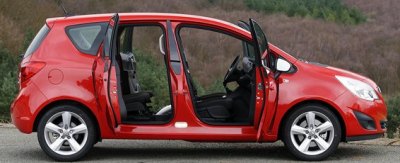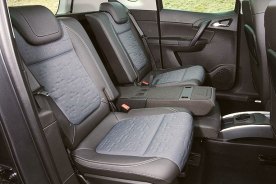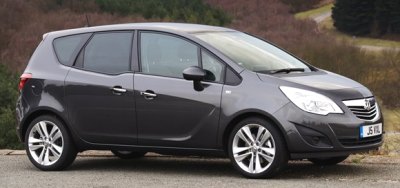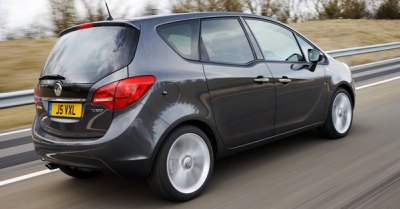Opel Meriva
Debut: 2010 |
|||||||||||
FlexSpace, FlexRail and FlexDoors. Flex is the key tone of new Opel Meriva. It all started in 2003. Smaller than the norm set by Renault Scenic, the original Meriva was the first B-segment-based MPV built by a European manufacturer. It was cheaper than contemporary rivals yet usefully bigger than the following FIAT Idea and Renault Modus. But what made the Meriva success was its flexible rear seat, called "FlexiSpace" instead of today's "FlexSpace". It was designed to deal with the compromise between 2 and 3 people accommodation. You could put three adults onto the back seat at a squeeze, but in case two were on board, the FlexiSpace seat could be converted to a double seat – flipped away the center cushion, slid the outer two inward and the two guys would be served with plenty of shoulder room. Wanna more legroom ? No problem, as the seats were no longer blocked by rear wheel wells, they could slide back into the luggage area, liberating another 200 mm for your knees to stretch. In this way, the old Meriva sold 1 million copies in 6 years. Good enough for Opel to increase investment on the second generation.
Part of the new money was put to develop FlexDoors, or rear-hinged doors in our language. The name sounds silly (are there any doors not flexible ?), and the concept seemed gimmicky at first sight. Without ditching the B-pillars, its benefit to rear seat access is doubtful. Moreover, unlike the prestige passengers of Rolls-Royce Ghost, those at the back of Meriva are unlikely to care about how to "entry and exit as gracefully as possible". So what is the purpose of FlexDoors ? You will understand only if you have children. Rear-hinged doors are very convenient for parents to access child seats and to assist their children get on and off, because the rear doors no longer block your way. After all, most MPVs are sold to families, so this feature should be attractive to most buyers. Another new feature is FlexRail. In contrast to FlexDoors, its concept sounds greater than it actually works. It is basically a rail running between the front seats onto which storage box or other accessories can be plugged. Problem is, the FlexRail does not run the full length of the cabin, so its space and possibilities are fairly limited. It should work better in a 4-seater like the forthcoming Mini Countryman. On the Meriva, the FlexRail actually compromises the legroom of center rear passenger.
The FlexSpace rear seat on the new car is mostly unchanged, except its range of longitudinal adjustment is now even more generous at 250 mm. On the downside, it is not the most friendly to luggage loading. The rear seats do fold, but they do not fold flat onto the floor. Besides, at 400 liters including the spare wheel well, the boot is not particularly generous. With rear seats up or down, the Meriva cannot match Citroen C3 Picasso for sheer luggage space, even though the Ciroen is smaller outside. Nevertheless, its defeat in space is more than made up by its Germanic build quality – even though it is actually produced in Spain. In fact, build quality is the single most improved area of the new Meriva. While the old car was criticized for nasty hard plastic and poor fit and finish, the new car feels as expensive as a Mercedes A-class. The dash top is covered with soft plastic. The dials are stylish and the console shares a lot of switch gears with Insignia. Outside, the Meriva also looks like Mercedes A-class, thanks to its elegant styling and quality finish. The kick at its waist line looks interesting.
Comparatively, the mechanical side is less remarkable. Meriva offers 6 engines from launch, 5 of them are turbocharged. Unfortunately, none of them provides satisfying blend of performance and refinement like FIAT's Multiair or Volkswagen's TSI engines, or to lesser extent the 1.4 TCE engine of Renault. Opel's 1.3CDTi and 1.7CDTi are not exactly world class diesel engines, so majority of sales may go to the 1.4 Turbo petrol engine, which is available in 120hp or 140hp form. Neither provide the elastic power band of their rivals. The lower power version is sluggish (not helped by long gearing), while the higher power unit is reluctant to rev. Both produce a coarse vocal at higher rpm to discourage enthusiastic driving. Not just the engines, the chassis and the overall package also lacks refinement. On highway, the Meriva is troubled by quite a lot of tire noise and wind noise, making its cabin the noisiest place among key rivals. This damages the quality feel it wanted to deliver. Opel should improve its sound insulation.
For a car whose target customers are family men and women with small children, we are surprised to find out its chassis tuning biases towards the sporty side. Its steering, brake and clutch are heavy. Suspension setting is hard to the extent that the ride becomes annoyingly harsh on less than smooth surfaces. It improves as speed rises, but expansion joints on motorway can still transmit shocks to the cabin. On the flip side, the stiff suspensions resist roll very well. Handling is tidy and confidence inspiring. Still, a more supple ride and higher level of refinement should fit the purpose better. Undoubtedly, the new Meriva has a lot of showroom appeal. It looks stylish and high quality. Its FlexDoor and FlexSpace are unique yet useful features. However, once you drive it off the dealer, you will be disappointed with its lack of mechanical refinement. It driving dynamics does not match the rest of the car, showing two contradicting characters. In the end, it does not fulfills the job of a small family MPV as well as Renault Scenic or Citroen C3 Picasso. |
|||||||||||
| The above report was last updated on 13 May 2010. All Rights Reserved. |
| Specifications | ||||||||||||||||||||||||||||||||||||||||||||||||||||||||||||||||||||||||||||||||||||||||
|
||||||||||||||||||||||||||||||||||||||||||||||||||||||||||||||||||||||||||||||||||||||||
| Performance tested by: *Autocar |
Copyright©
1997-2010
by Mark Wan @ AutoZine





